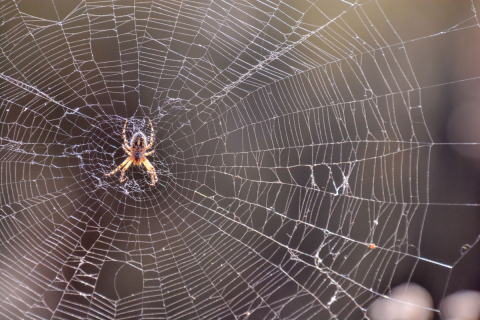Spiders caught in a web of Internet lies

It’s no secret that the internet and social media fuel rampant spread of misinformation in many areas of life. A collective of researchers, including Catherine Scott, Postdoctoral Fellow in McGill University’s Lyman Lab, have explored this phenomenon as it applies to news about spiders. The verdict? Don’t blindly trust anything you read online about these eight-legged arthropods—or anything else for that matter—and always consider the source.
“The quality of spider information in the global press is rather poor—errors and sensationalism are rampant,” says Stefano Mammola of the National Research Council, Verbania Pallanza, Italy, and University of Helsinki’s Finnish Museum of Natural History. “Spider-related information in the press flows through a highly interconnected global network, and the spread of misinformation is driven by a limited number of key factors, the sensationalistic tone of an article being particularly important.”
Starting at the local level
Stefano Mammola said he was inspired to do the study initially based on general disappointment about the quality of spider-related newspaper articles in Italy. “Many articles on spiders in the Italian press are full of errors, alarmistic, or even fake news, or a combination thereof,” he says.
So, he and dozens of colleagues wanted to see whether this was a global problem. They put together an impressive team of experts to collect all the data, representing 41 languages and 81 countries. During the COVID-19 pandemic, the project also offered a way to explore important questions on a global scale at a time when spider fieldwork had been halted without leaving home to do it.
“We found that the level of sensationalism and misinformation drops when the ‘right’ expert—namely an expert on spiders rather than a medical doctor or other professional—is consulted by journalists doing the writing,” explains Stefano Mammola.
“This result is actually really encouraging, because it suggests that there is a solution to this problem” explains Catherine Scott. The authors plan to create a global database of arachnologists that are willing to speak to journalists and they are working on a set of guidelines for journalists covering stories about spiders.
The data amassed also showed the importance of events and news coverage on a local scale, as small-town stories can quickly hit the international news. “I was particularly surprised by the fact that even very local-scale events—say, the story of a farmer bitten by a spider in some remote village in Australia—published by a regional newspaper can quickly become broadcast internationally,” Mammola explains. “This implies that improving the quality of the information produced in these local nodes could have a positive effect reverberating across the information network—a typical example of a ‘think globally, act locally’ management strategy”.
Blowing things out of proportion
Misinformation about spiders has many real-world implications. Some notable cases have led to school closures due to alarmist responses to false widow “invasions,” they report. In another instance, a man lit his house on fire while blowtorching (harmless) spider webs from his backyard. The tone and quality of “news” stories about spiders shape people’s perception and ideas about them, with implications for them and for spiders’ wildlife conservation.
As for next steps, the researchers now want to explore more about how poor-quality information on spiders relates to the persistence of arachnophobic sentiments in the population. They also want to understand better how differences in cultural, social, and other factors influence differences in the way spiders are represented and talked about across various countries and regions. Ultimately, they may even expand the work beyond spiders.
|
About this study “The global spread of misinformation on spiders” by Stefano Mammola and al., was published in Current Biology. |
About McGill University
Founded in Montreal, Quebec, in 1821, McGill University is Canada’s top ranked medical doctoral university. McGill is consistently ranked as one of the top universities, both nationally and internationally. It is a world-renowned institution of higher learning with research activities spanning three campuses, 11 faculties, 13 professional schools, 300 programs of study and over 39,000 students, including more than 10,400 graduate students. McGill attracts students from over 150 countries around the world, its 12,000 international students making up 30% of the student body. Over half of McGill students claim a first language other than English, including approximately 20% of our students who say French is their mother tongue.